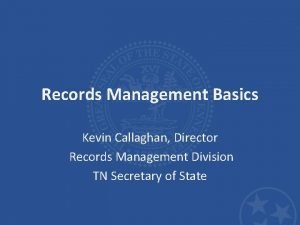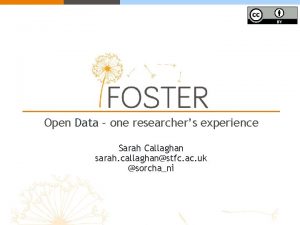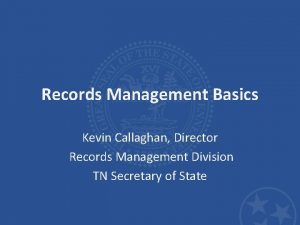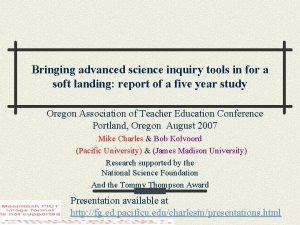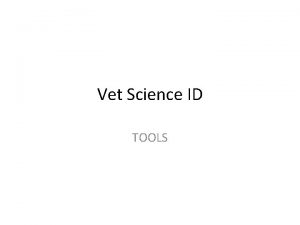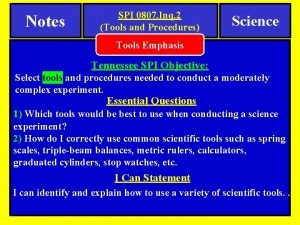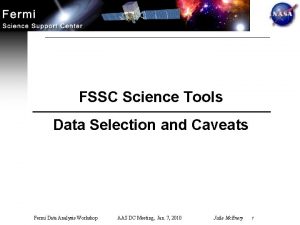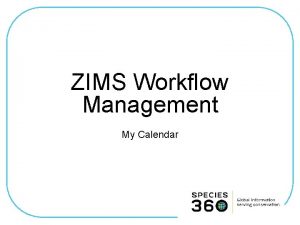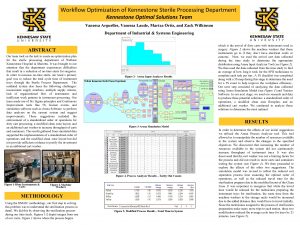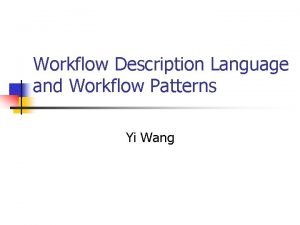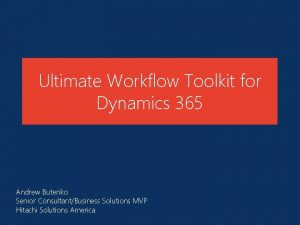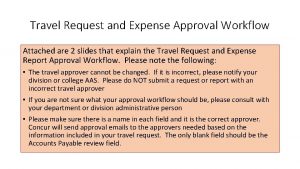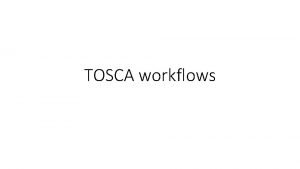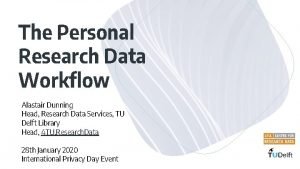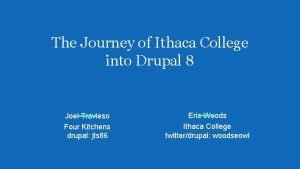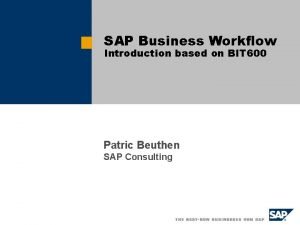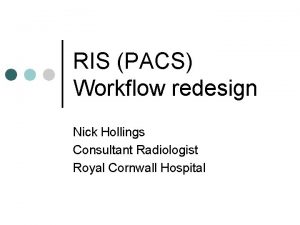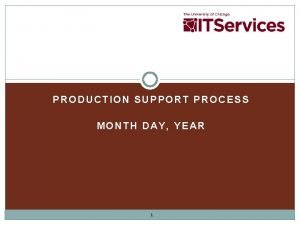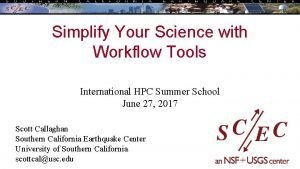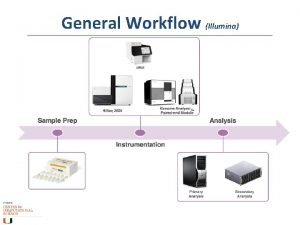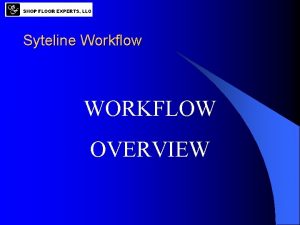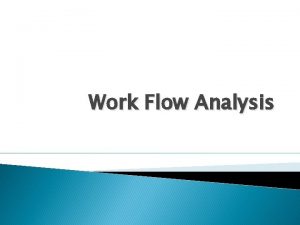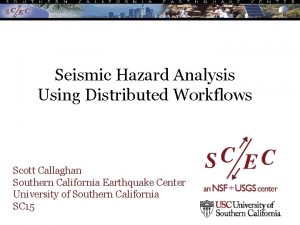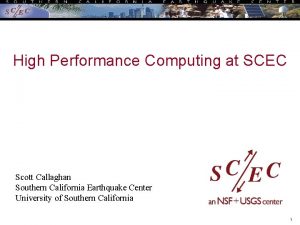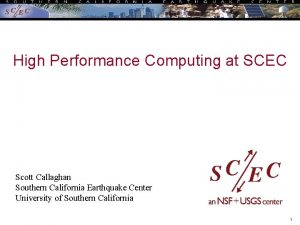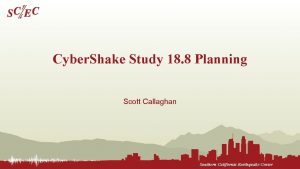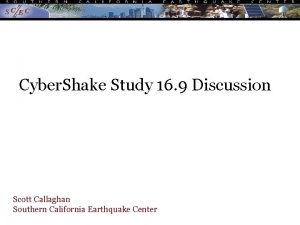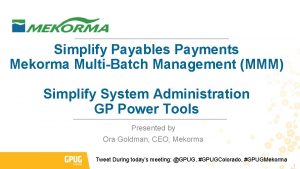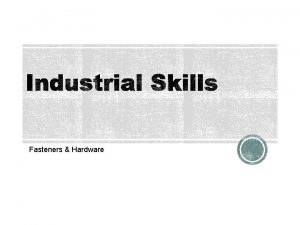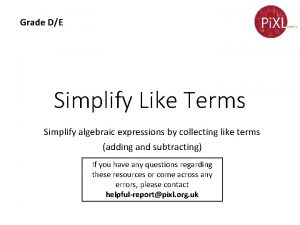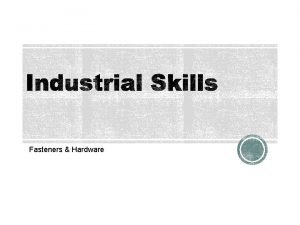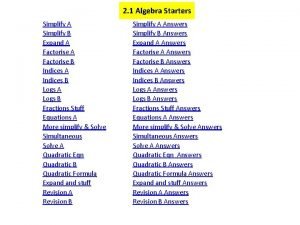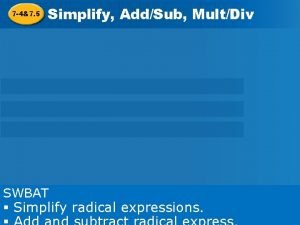Simplify Your Science with Workflow Tools Scott Callaghan






























- Slides: 30

Simplify Your Science with Workflow Tools Scott Callaghan scottcal@usc. edu 2019 IHPCSS July 11, 2019 Southern California Earthquake Center

Overview • What are scientific workflows? • What problems do workflow tools solve? • Overview of available workflow tools • Seismic hazard application (Cyber. Shake) Computational overview • Challenges and solutions • • Ways to simplify your work • Goal: Help you figure out if this would be useful Southern California Earthquake Center 1

Scientific Workflows • Formal way to express a scientific calculation • Multiple tasks with dependencies between them • No limitations on tasks • Capture task parameters, input, output • Workflow process and data are independent • Often, run same workflow with different data • You use workflows all the time… Southern California Earthquake Center 2

Perhaps your workflow is simple… stage-in parallel job post-process Southern California Earthquake Center stage-out 3

…or maybe a bit more complicated… Job 1 pre-process Job 2 visualize publish Job 3 Job 4 Southern California Earthquake Center 4

…or maybe just confusing stage-in that other file edit file names parallel job post-process again if it failed stage-out post-process do you still need this job? job you always forget job from past postdoc Southern California Earthquake Center email your supervisor 5

Workflow Components • Task executions with dependencies • Specify a series of tasks to run • Outputs from one task may be inputs for another • Task scheduling • Some tasks may be able to run in parallel with other tasks • File management • Inputs must be present for tasks to run • Metadata • Track when a task was run, key parameters • Resource provisioning (getting processors) • Computational resources are needed to run jobs Southern California Earthquake Center 6

What do we need help with? • Task executions with dependencies What if something fails in the middle? • Dependencies may be complex • • Task scheduling • Minimize execution time while preserving dependencies • File management • Make sure inputs are available for tasks • Metadata • Automatically capture and track • Matching jobs to processors (across multiple systems? ) Southern California Earthquake Center 7

Workflow tools can help! • Automate your pipeline • Define your workflow via programming or GUI • Run workflow on local or remote system • Can support all kinds of workflows • Use existing code (no changes) • Provide many kinds of fancy features and capabilities • Flexible, but can be complex • Will discuss one set of tools (Pegasus) as example, but concepts are shared Southern California Earthquake Center 8

Pegasus-WMS • Developed at USC’s Information Sciences Institute • Used in many science domains, including LIGO project • Workflows are executed from local machine • Jobs can run on local machine or on distributed resources • You use API to write code describing workflow (“create”) • Python, Java, or Perl • Define tasks with parent / child relationships • Describe files and their roles • Pegasus creates XML file of workflow called a DAX • Workflow represented by directed acyclic graph Southern California Earthquake Center 9

input. txt my_job output. txt Sample Workflow Creation //Create DAX object dax = ADAG("test_dax") //Define my job my. Job = Job(name="my_job") //Input and output files to my job input. File = File("input. txt") output. File = File("output. txt") //Arguments to my_job (. /my_job input=input. txt output=output. txt) my. Job. add. Argument("input=input. txt", "output=output. txt") //Role of the files for the job my. Job. uses(input. File, link=Link. INPUT) my. Job. uses(output. File, link=Link. OUTPUT) //Add the job to the workflow dax. add. Job(my. Job) //Write to file fp = open("test. dax", "w") dax. write. XML(fp) fp. close() Southern California Earthquake Center 10

Getting ready to run (“Planning”) • DAX is “abstract workflow” Logical filenames and executables • Algorithm description • • Use Pegasus to “plan” workflow for execution Uses catalogs to resolve logical names, compute info • Pegasus automatically augments workflow • Staging jobs (if needed) with scp/wget/Grid. FTP • Registers output files in a catalog to find later • Wraps jobs in pegasus-kickstart for detailed statistics • • Generates a DAG Top-level workflow description (tasks and dependencies) • Submission file for each job • Southern California Earthquake Center 11

Pegasus Workflow Path Create workflow description (you write this) Plan Jobs Execute Run DAX API Scheduler (HTCondor) Abstract workflow (DAX) Concrete workflow (DAG) Logical names, algorithm Physical paths, job scripts Southern California Earthquake Center 12

Other tools in stack • HTCondor (University of Wisconsin Madison) Pegasus ‘submits’ workflow to HTCondor • Supervises runtime execution of DAG files • Maintains job queue • Monitors dependencies • Schedules jobs • • Retries failures • Writes checkpoint • Tools for remote job submission to clusters and clouds SSH, GRAM, BOSCO, CREAMCE, glideins/pilot jobs, … • Condor uses these tools to match jobs to resources • Southern California Earthquake Center 13

Full workflow stack What you do: Create workflow description What the Pegasus tools do: Local machine HTCondor local queue Remote machine SSH/ GRAM/ etc. Remote scheduler remote queue DAG Southern California Earthquake Center 14

Other Workflow Tools • Regardless of the tool, same basic stages Describe your high-level workflow (Pegasus “Create”) • Prepare your workflow for the execution environment (Pegasus “Plan”) • Schedule and run your workflow (HTCondor) • Send jobs to remote resources (SSH, GRAM, pilot jobs) • Monitor the execution of the jobs (HTCondor DAGMan) • • Brief overview of some other available tools • All support large-scale workflows Southern California Earthquake Center 15

Other Workflow Tools • Swift (University of Chicago) • Workflow defined via scripting language • Airflow • • //Create new type messagefile; //Create app definition, returns messagefile app (messagefile t) greeting() { //Print and pipe stdout to t echo “Hello, world!” stdout=@filename(t); } //Create a new messagefile, linked to hello. txt messagefile outfile <“hello. txt”> //Run greeting() and store results outfile = greeting(); • • • (Apache project / Airbnb) Workflow defined with Python API Description used to write DAGs Internal scheduler triggers tasks Support for Kubernetes (deploys containers) Web UI for getting status Workflow compiled internally and executed • Focus on large data, many tasks • Southern California Earthquake Center 16

Other Workflow Tools • JUBE (Jülich Supercomputing Center) • Designed for automating benchmarks and testing on multiple systems • Workflow described via XML files • Makeflow (Notre Dame) • Makefile-type syntax to specify workflow • • Targets are output files, dependent on input files, with execution string to run Can work with Work Queue for management of compute resources (workers) • Multiple clusters, pilot jobs, dynamic worker pool • Nextflow (Barcelona Centre for Genomic Regulation) • Uses dataflow paradigm: tasks write/read from channels (not always a file) • Custom scripting language for defining workflows • Many more! Ask me about specific use cases Southern California Earthquake Center 17

Workflow Application: Cyber. Shake • What will peak earthquake shaking be over the next 50 years? Used in building codes, insurance rates, disaster planning • Answered via Probabilistic Seismic Hazard Analysis (PSHA) • Get list of all possible earthquakes • Figure out how much shaking each causes • Combine shaking levels with probabilities • 2% in 50 years 0. 4 g Southern California Earthquake Center 18

Cyber. Shake Computational Requirements • Determine shaking of ~300, 000 earthquakes per site • 2 large parallel jobs Wave propagation • 1200 GPUs x 1 hr • 340 GB total output • • 300, 000 small serial jobs Calculate seismograms and shaking measures • 1 core x 4 min • 17 GB total output • • Need ~900 sites for hazard map Southern California Earthquake Center 19

Cyber. Shake Challenges • Automation • Too much work to run by hand • Data management Input files need to be moved to cluster • Output files transferred back for archiving • • Error recovery • Detect and recover from basic errors automatically • Resource provisioning • How to execute large numbers of small tasks? • Decided to use scientific workflows • Selected Pegasus-WMS Southern California Earthquake Center 20

Challenge: Resource Provisioning • For large parallel GPU jobs, submit to remote scheduler GRAM (or other tool) puts jobs in remote queue • Runs like a normal batch job • Can specify either CPU or GPU nodes • • For small serial jobs, need high throughput • Putting lots of jobs in the batch queue is ill-advised Scheduler isn’t designed for heavy job load • Scheduler cycle is ~5 minutes • Policy limits number of job submissions • • Solution: Pegasus-mpi-cluster (PMC) Southern California Earthquake Center 21

Pegasus-mpi-cluster (PMC) • MPI wrapper around serial or thread-parallel jobs Master-worker paradigm • Preserves dependencies • HTCondor submits job to multiple nodes, starts PMC • Specify jobs as usual, Pegasus does wrapping • • Uses intelligent scheduling Core counts • Memory requirements • • Can combine writes • Workers write to master, master aggregates to fewer files • Developed for our application Southern California Earthquake Center 22

Challenge: Data Management • Millions of data files • Pegasus provides staging Symlinks files if possible, transfers files if needed • Transfers output back to local archival disk • Supports running parts of workflows on separate machines • Cleans up temporary files when no longer needed • Directory hierarchy to reduce files per directory • • We added automated checks to check integrity Correct number of files, Na. N, zero-value checks, correct size • Included as new jobs in workflow • Southern California Earthquake Center 23

Cyber. Shake Study 18. 8 • Hazard results for 869 sites • Used OLCF Titan and NCSA Blue Waters • 1/3 of workflows ran jobs on both systems • 6. 2 million node-hours (120 M core-hours) • Averaged 2, 018 nodes (CPUs & GPUs) for 128 days • Max of 16, 219 nodes (~280, 000 cores) • Workflow tools scheduled 17, 921 jobs • Workflow tools managed 1. 2 PB of data • 157 TB of data automatically transferred • 14. 4 TB (~12 M files) staged back to local disk • Workflow tools scale! Southern California Earthquake Center 24

Problems Workflows Solve • Task executions • Workflow tools will retry and checkpoint if needed • Data management • Stage-in and stage-out data for jobs automatically • Task scheduling • Optimal execution on available resources • Metadata • Automatically track runtime, environment, arguments, inputs • Getting computational resources • Whether large parallel jobs or high throughput Southern California Earthquake Center 25

Should you use workflow tools? • Probably using a workflow already • Replaces manual hand-offs and polling to monitor status • Provides framework to assemble community codes • Also useful for training new teammates • Scales from local computer to large clusters • Provide portable algorithm description independent of data • Cyber. Shake has run on 9 systems since 2007 with same workflow • Does additional software layers and complexity • Some development time is required Southern California Earthquake Center 26

Final Thoughts • Automation is vital, even without workflow tools Eliminate human polling • Get everything to run automatically if successful • Be able to recover from common errors • • Put ALL processing steps in the workflow • Include validation, visualization, publishing, notifications • Avoid premature optimization • Consider new compute environments (dream big!) • Larger clusters, XSEDE/PRACE/RIKEN/Sci. Net, Amazon EC 2 • Tool developers want to help you! Southern California Earthquake Center 27

Links • SCEC: http: //www. scec. org • Pegasus: http: //pegasus. isi. edu • Pegasus-mpi-cluster: http: //pegasus. isi. edu/wms/docs/latest/cli-pegasus-mpi • • cluster. php HTCondor: http: //www. cs. wisc. edu/htcondor/ Swift: http: //swift-lang. org Apache Airflow: https: //airflow. apache. org/ JUBE: https: //www. fz-juelich. de/ias/jsc/EN/Expertise/Support/Software/JUBE/_node. html Makeflow: http: //ccl. cse. nd. edu/software/makeflow/ Work Queue: http: //ccl. cse. nd. edu/software/workqueue/ Nextflow: https: //www. nextflow. io/ Cyber. Shake: http: //scec. usc. edu/scecpedia/Cyber. Shake Southern California Earthquake Center 28

Questions? Southern California Earthquake Center 29
 Tim callaghan
Tim callaghan Dr sarah callaghan
Dr sarah callaghan Dr james callaghan
Dr james callaghan Rda callaghan
Rda callaghan My favourite subject is
My favourite subject is Give us your hungry your tired your poor
Give us your hungry your tired your poor Marking tools in sewing
Marking tools in sewing Why are line graphs powerful tools in science
Why are line graphs powerful tools in science Tools of environmental science
Tools of environmental science Units of mean free path
Units of mean free path Why are line graphs powerful tools in science
Why are line graphs powerful tools in science Tools of environmental science
Tools of environmental science Science inquiry tools
Science inquiry tools Dehorner barnes
Dehorner barnes Science tools
Science tools Fermi science tools
Fermi science tools Fermi science tools
Fermi science tools Chapter 2 tools of environmental science answer key
Chapter 2 tools of environmental science answer key Workflow management with calendar
Workflow management with calendar Sterile processing department workflow
Sterile processing department workflow Acme workflow management
Acme workflow management Workflow patterns examples
Workflow patterns examples Ultimate workflow toolkit
Ultimate workflow toolkit Travel request approval workflow
Travel request approval workflow Tosca workflow
Tosca workflow Dunning workflow
Dunning workflow Ithaca college workflow
Ithaca college workflow Sap business workflow architecture
Sap business workflow architecture Nick hollings
Nick hollings Microsoft dynamics nav purchase order workflow software
Microsoft dynamics nav purchase order workflow software Production support process
Production support process
